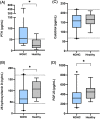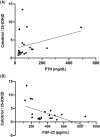Calcium and phosphate homeostasis in dogs with newly diagnosed naturally occurring hypercortisolism
- PMID: 33991143
- PMCID: PMC8163130
- DOI: 10.1111/jvim.16143
Calcium and phosphate homeostasis in dogs with newly diagnosed naturally occurring hypercortisolism
Abstract
Background: Hypercortisolism affects calcium and phosphate metabolism in dogs; however, the exact mechanisms are not completely understood.
Objectives: To evaluate circulating concentrations of whole parathormone (wPTH), 25-hydroxyvitamin D (25-(OH)D), calcitriol, and fibroblast growth factor-23 (FGF-23) in dogs with naturally occurring hypercortisolism (NOHC) and healthy dogs, and their association with calcium and phosphate homeostasis.
Animals: Twenty-three client-owned dogs with NOHC, and 12 client or staff-owned healthy dogs.
Methods: Prospective cross-sectional study. The circulating concentrations of total calcium, ionized calcium (iCa), phosphate, wPTH, 25-(OH)D, calcitriol and FGF-23, and the urinary fractional excretion of phosphate (FEP) and calcium (FECa) were compared between dogs with NOHC before treatment and healthy dogs.
Results: Dogs with NOHC had higher mean serum phosphate concentrations (4.81 mg/dL, SD ± 0.71 vs 3.86 mg/dL, SD ± 0.60; P < .001), median FECa (0.43%, range, 0.03-2.44 vs 0.15%, range, 0.06-0.35; P = .005), and median serum wPTH concentrations (54.6 pg/mL, range, 23.7-490 vs 24.6 pg/mL, range, 5.5-56.4; P = .003) as compared to the controls. Circulating concentrations of total calcium, iCa, and calcitriol and the FEP did not differ between groups, whereas the serum 25-(OH)D concentrations were lower in dogs with NOHC as compared to the controls (70.2 pg/mL, SD ± 42.3 vs 106.3 pg/mL, SD ± 35.3; P = .02). The dogs with NOHC had lower plasma FGF-23 concentrations than controls (316.6 pg/mL, range, 120.8-575.6 vs 448.7 pg/mL, range, 244.8-753; P = .03).
Conclusions and clinical importance: Urine loss of calcium and hyperphosphatemia could contribute to the adrenal secondary hyperparathyroidism.
Keywords: FGF-23; calcitriol; hyperadrenocorticism; parathyroid hormone; urinary calcium excretion; vitamin D.
© 2021 The Authors. Journal of Veterinary Internal Medicine published by Wiley Periodicals LLC on behalf of American College of Veterinary Internal Medicine.
Conflict of interest statement
Authors declare no conflict of interest.
Figures




Similar articles
-
Effects of calcifediol supplementation on markers of chronic kidney disease-mineral and bone disorder in dogs with chronic kidney disease.J Vet Intern Med. 2020 Nov;34(6):2497-2506. doi: 10.1111/jvim.15949. Epub 2020 Oct 31. J Vet Intern Med. 2020. PMID: 33128421 Free PMC article.
-
Phosphocalcic metabolism and its potential association with biomarkers of kidney disease in dogs with spontaneous hyperadrenocorticism.Vet J. 2024 Jun;305:106146. doi: 10.1016/j.tvjl.2024.106146. Epub 2024 May 22. Vet J. 2024. PMID: 38788995
-
Vitamin D metabolites and parathyroid hormone in Cushing's syndrome: relationship to calcium and phosphorus homeostasis.J Clin Endocrinol Metab. 1982 May;54(5):1039-44. doi: 10.1210/jcem-54-5-1039. J Clin Endocrinol Metab. 1982. PMID: 6977549
-
Regulatory mechanisms of circulating fibroblast growth factor 23 in parathyroid diseases.Ther Apher Dial. 2007 Oct;11 Suppl 1:S32-7. doi: 10.1111/j.1744-9987.2007.00519.x. Ther Apher Dial. 2007. PMID: 17976083 Review.
-
1alpha(OH)D3 One-alpha-hydroxy-cholecalciferol--an active vitamin D analog. Clinical studies on prophylaxis and treatment of secondary hyperparathyroidism in uremic patients on chronic dialysis.Dan Med Bull. 2008 Nov;55(4):186-210. Dan Med Bull. 2008. PMID: 19232159 Review.
Cited by
-
Pamidronate-induced irreversible symptomatic hypocalcemia in a dog with hypercalcemia after glucocorticoid withdrawal: a case report.BMC Vet Res. 2024 May 24;20(1):227. doi: 10.1186/s12917-024-04030-x. BMC Vet Res. 2024. PMID: 38790012 Free PMC article.
-
Acquired hypocalciuric hypercalcemia in a dog.J Vet Med Sci. 2025 Aug 1;87(8):876-880. doi: 10.1292/jvms.25-0112. Epub 2025 Jun 17. J Vet Med Sci. 2025. PMID: 40533243 Free PMC article.
References
-
- Bennaim M, Shiel RE, Mooney CT. Diagnosis of spontaneous hyperadrenocorticism in dogs. Part 1: pathophysiology, aetiology, clinical and clinicopathological features. Vet J. 2019;252:105342. - PubMed
-
- Hess RS, Kass PH, Ward CR. Association between hyperadrenocorticism and development of calcium‐containing uroliths in dogs with urolithiasis. J Am Vet Med Assoc. 1998;212:1889‐1891. - PubMed
-
- Ramsey IK, Tebb A, Harris E, Evans H, Herrtage ME. Hyperparathyroidism in dogs with hyperadrenocorticism. J Small Anim Pract. 2005;46:531‐536. - PubMed
-
- Tebb AJ, Arteaga A, Evans H, Ramsey IK. Canine hyperadrenocorticism: effects of trilostane on parathyroid hormone, calcium and phosphate concentrations. J Small Anim Pract. 2005;46:537‐542. - PubMed
-
- Fracassi F, Malerba E, Furlanello T, Caldin M. Urinary excretion of calcium and phosphate in dogs with pituitary‐dependent hypercortisolism: case control study in 499 dogs. Vet Rec. 2015;117:625. - PubMed
MeSH terms
Substances
LinkOut - more resources
Full Text Sources
Other Literature Sources
Medical
Miscellaneous

